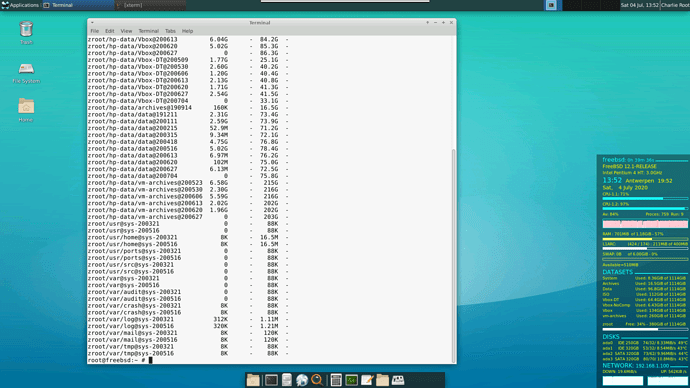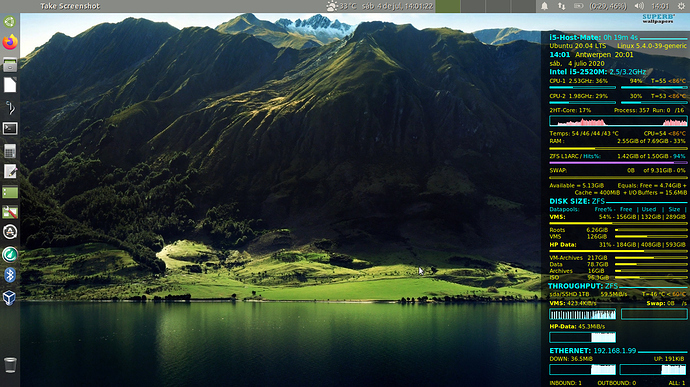Hey, @JasonEvangelho, LTT seems to have copied your earlier podcast idea, when you had an installation race (Linux .vs Windows).
My emotion was the output.
You could ask him on the noisy bird website, if you have an account there. I believe that’s LTT’s primary contact mechanism.
This week I learned more about Mattermost Team Server. I upgraded and migrated an install from one RPi4 to another. “Magic wormhole” was super helpful!
This week I’ve been trying out Artix linux and freeBSD. It’s been fun. Really loving the BSD documentation. So thorough, it’s like the amazing Arch wiki, but in a book that I actually like reading for fun!
Finally configured Netflix to run on the Raspberry Pi via Kodi.
This week so far I’ve done a quick survey of the latest from Fedora, U/X/Kubuntu, Kde neon, and Linux Mint. I may spin up openSuSE when the new one comes out. Back to Zorin for the time being.
edit - Scratch that. I’m digging Linux Mint 20. Slick distro.
Have a link to how you did that? I have a Pi Zero set aside specifically to be Kodi to eventually replace my Roku!
Sure. Though I have a Pi 3 and use LibreELEC that comes with Kodi 18 that supports DRM, this module is needed for Netflix.
There is no official Netflix add-on in the Kodi repos but you can grab it from here:
You have to enable third party repos to be allowed in Kodi. It also works on my laptop.
Actually it works really nice and I prefer the interface to Netflix’s web UI but it has some caveats like no hardware acceleration, no 4K on my TV and 1080p is not working on all hardware due to widevine limitations.
Thanks for the link and notes!
This week, I tried out ntopng, which is sort of like an Open Source clone of Glasswire. It has many interesting statistics and charts to look at. It helped me detect a box on the LAN which was sending and receiving quite a lot of traffic which I was unaware of!!
I did my periodic backup. This first screen gives an overview of the configuration of my main desktop in the conky window on the right. The two Tillix sub-windows show the 2 x 2 scripts I started for the backup, one set of scripts to backup to my backup server a Pentium 4 and one set to backup to my i5 laptop. Both run at the same time! Laptop and desktop will have exactly the same content, so except for screen size (and keyboard lay-out) I have exactly the same VMs, data and facilities on both desktop and laptop, because I moved all my “work” to the VMs ![]()
The second screen shows the desktop of my backup-server displayed by Remmina using the RDP protocol, while receiving the incremental backup. The transfer speed is ~20MB/s the bottleneck is the CPU load of 95%. The system runs FreeBSD 12.1 on ZFS. Configuration details are in the conky display on the right. The backup script looks like:
/sbin/zfs snapshot dpool/vm-archives@$2
/sbin/zfs send -c -i dpool/vm-archives@$1 dpool/vm-archives@$2 | ssh bertadmin@192.168.1.100 zfs receive -F zroot/hp-data/vm-archives
-i indicates incremental backup, so only the changed ZFS physical records are sent.
-c indicates those records are sent compressed “as stored” (lz4 compression-ratio ~1.8)
-F indicates delete any local changes to the dataset before the receive.
The third screen shows the desktop of my laptop an i5. The transfer speed is higher because there is less of a CPU bottleneck, normally it is ~80MB/s. The backup script looks like (note that the snapshot already exists):
/sbin/zfs send -c -i dpool/vm-archives@$1 dpool/vm-archives@$2 | ssh root@192.168.1.99 zfs receive -F hp-data/vm-archives
With respect to security, the router with changed user/password blocks all inbound traffic and so does the UFW firewall of the desktop. Laptop and back-up-server are powered-on for less than 1 hour/week.
My main workstation (running an Arcolinux spin called Hefftor Linux i3) basically lost it’s mind and the video subsystem went South on me. Reinstalling the system caused it to die after the first update. Ubuntu and other Debian derivatives worked fine, but I am kind of hooked on Arch-based distros and TWM’s. Ended up installing Manjaro i3 on my main workstation and it’s working fine except for one REALLY annoying thing: for some inexpicable reason the system creates a /home/root folder with a set of empty folders underneath.If I delete it, it comes back after a few days. I have scanned my hard drive and found no reference to /home/root. I have run inotifywatch to monitor the creation of folders and they were created without it noticing. journalctl has nothing either unless I mess with the folder. I am at my wits end.
KDE saved me some trouble in bit funny way.
I like playing indie games and rarely there are some that play windowed with low fixed resolution that cannot be changed.
Normally it’s not a problem, but I have 4K monitor and the pixels are really small, so some of those games are barely playable because their window is tiny.
KDE desktop comes to the rescue, as it allows do zoom in on any part of the desktop, so I can finally play my games without gluing my head to the screen.
This week, I tried a free week’s demo with ScaleEngine, as I’m almost certainly going to embed some live video streaming into my website. There’s lots of terminology to learn about here, like HLS, RTMP, VOD, etc. I also learned about embedding the “clappr” Javascript video player, to play the video streams on a web page.
It took me a good couple of days to wrap my head around what Scale Engine does, and how it works. Furious tinkering, and plenty of coffee helped me to break through. Once I got it working, now I’m quite impressed with Scale Engine.
This week I went nuts distro-hopping on the Inspiron 5593. I tried OpenSuSE 15.2, Fedora 32, Kubuntu/Ubuntu/Ubuntu Budgie 20.04, PopOS 20.04, and Solus. Ended up on Ubuntu Budgie for the time being. That may change tomorrow.
Tangentially related - I’m tracking a number of LokiSoft boxed Linux games from my college days on eBay. Waiting for a payday. I’ve been gaming on Card City Nights from GOG lately.
Sounds like me too to be honest.
I like to think I’ve settled on Kubuntu for good, but I almost hopped to OpenSUSE yesterday. ![]()
Would this be the FreeBSD Handbook, or perhaps Michael W. Lucas’ Absolute FreeBSD? (I have a copy coming in the mail!)
The freeBSD handbook available on the website. I was thinking of getting that book as well. You’ll have to let me know how it is.
Hasn’t quite been a week but I ran into some interesting problems over the weekend in relation to my laptop’s UEFI and the TPM chip. I’ve been having boot issues, and it appears the firmware polls and resets some of its settings to the Windows default despite there not being a Windows install present. Fun little “feature,” Dell.
UPDATE - knocks on wood
I may have figured out the setting. I spent the morning digging around my BIOS/UEFI and found something that tries to reload the BIOS from disk. Disabled it. No boot problems…yet.


